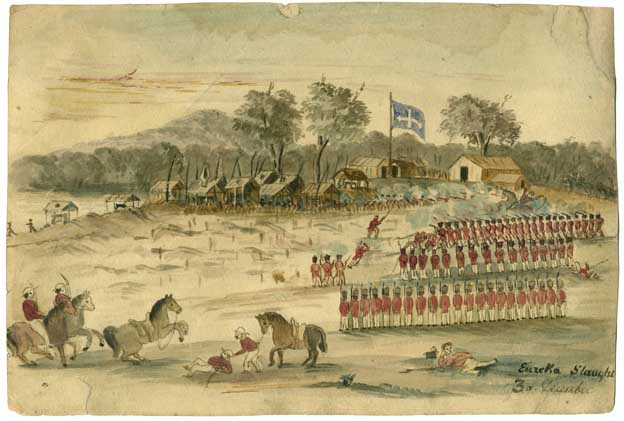Eureka 150
Contents
Presentation to Parliament for Eureka 150
Exactly 150 years since the Ballarat Reform League presented their Charter for ratification to over 10,000 miners on Bakery Hill on 11 November 1854, the Mayor of Ballarat, Councillor David Vendy, presented a framed copy of the four page Charter to the Victorian Parliament. The historic presentation, which received bipartisan support form all sides of government concluded with Premier Steve Bracks stating the charter "Was ahead of its time. The Ballarat Reform League Charter is a landmark document in the history of our nation. it is our Declaration of Independence. Our Magna Carter. And a cornerstone of Australian democracy."<Ballarat Courier, 12 November 2004.</ref>
The Eureka Flag flew on the Victorian Parliament house on 11 November 2004 to commemorate the 150th anniversary of the Charter's ratification. [1]
Speeches
Speech by Professor Geoffrey Blainey presented this speech at the launch by Australia Post of its Eureka Stockade 150th Anniversary Stamp Issue on the steps of Parliament House Melbourne and at The Eureka Centre Tuesday 29th June 2004.
"It¹s just a postage stamp, but it will arouse mountains of discussion. The battle at the Eureka Stockade was all over in an hour, but many people are still arguing about it. The event will provoke nation-wide debate this year, the 150th anniversary. Congratulations to Australia Post for honouring this event with such fidelity to history.
Nearly every political party and group in Australia has claimed a special link with Eureka. The Labor Party, the Liberal Party, the old DLP, the Nationals, the Communists, the Republicans, the Multiculturalists, the upholders of civil liberties, the opponents of excessive government regulation, the opponents of the national identity card, today¹s trade union movement, today¹s mining prospectors - they all pluck a different message from the Eureka Stockade.
Next to Gallipoli this is probably the most debated military event in our history. Of course it is older than Gallipoli. Curiously the leader of the Eureka rebellion, Peter Lalor, lost a grandson at Gallipoli.
What actually happened? Ballarat in 1854 was one of the most populous goldfields the world had seen. A spreading metropolis of tents and huts and shops and hotels, it was pockmarked with mining holes and shafts, shallow and deep.
But the miners were hit by outdated regulations and taxes. Everybody had to buy an expensive licence, even if he earned no income. And the police who hunted for the unlicensed miners - they were not the salt of the earth.
In the end there were massive meetings of protest, the symbolic burning of mining licences, the designing of a revolutionary flag, angry talk of a republic, the collecting of guns and ammunition, and the building of a simple wooden fort or stockade. It was the only serious rebellion in our history.
The months of protest involved massive public support from the miners, but the final rebellion did not. The Victorian government had no option but to storm the stockade; every government in Europe would have done likewise. Soldiers and police made a surprise attack at dawn one Sunday morning. The death toll was 30 miners and five soldiers.
What lessons should we draw? We each will have our own ideas.
Firstly, the gold miners were demanding a ‘fair go’. This powerful democratic movement aired genuine grievances. The government did not listen attentively enough, did not act quickly enough.
Secondly, Australia is one of the oldest, continuous democracies in the world. Democracy means government by debate, government by discussion. The months of protests by miners strengthened that tradition. But the final building of the stockade and the one morning of battle defied that tradition.
We should celebrate Eureka and its democratic protests as a landmark event in Australian history. But we should not go too far in celebrating the battle itself, exciting and tragic as it was. The main lesson of Eureka is that debate, negotiation and compromise are more effective and humane than an appeal to arms".
Geoffrey Blainey 29 June 2004
Eureka Commemorative Coin
The Royal Australian Mint struck a coin commemorating the 150th anniversary of the Eureka Stockade. For three days only coin enthusiasts had a chance to strike an E mintmark on the coin, with the mintmark machine operating at the Eureka Stockade Centre. It was the first time in the mint's history that an E had been struck on a coin. [2]
The commemorative coin is an aluminium bronze $1 coin featuring a design by the winner of the Sydney Olympic victory medal competition, Wojciech Pietranik. Polish born Pietranik drew inspiration from the Charles Doudiet Eureka Slaughter painting. [3]
Eureka 150 Democracy Conference
The Eureka 150 Democracy Conference was held from Thursday 25 November 2004 until Saturday 27 November, at the University of Ballarat Caro Conference Centre, Mt Helen.
Eureka Encyclopeadia
After more than 20 years research the Eureka Encyclopaedia was launched on 01 December 2005 by Ballarat MHR Catherine King. With funding denied, the authors Justin Corfield, Dorothy Wickham and Clare Gervasoni published the tome as a 'labour or love'. The believe it is the one lasting tribute that will remain from the Eureka 150 celebrations.
In 2005 the Eureka Encyclopaedia was the overall winner of the Victorian Community History Awards.
Eureka Circle
Dr Anton Hasell's Eureka Circle sculpture was erected in the Eureka Stockade Memorial Park to celebrate the 150th anniversary of the Eureka Stockade. The sculpture comprises of 20 steel panels depicting the Eureka story. Dr Hasell said he designed the interpretive sculpture with the intention of creating an experience facing every mner on the goldfields at that time - either to join in or to stay out. The artist wanted visitors to experience the feeling of entering the barricade, to cross a line with many layers attached to it. [4]



